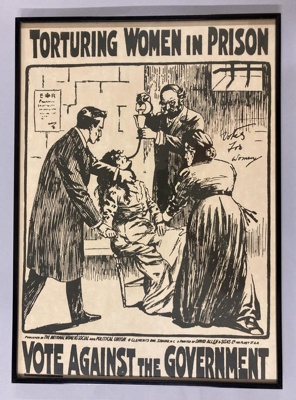Name/TitleFramed print: Torturing Women in Prison
About this objectFramed reproduction print of a poster published by the WSPU in Votes for Women newspaper on 29th October 1909. The image depicts the forcible feeding of a suffragette prisoner via a rubber tube that passed through the nose (though this was more usually done through the mouth) and into the stomach.
MakerWSPU
Date Made1909
Period1900s
Place MadeEngland, London
Place NotesWomen's Social and Political Union, 4 Clements Inn, Strand, W.C.
Medium and MaterialsInorganic, glass
Organic, paper and wood
MeasurementsH: 630 x W: 457 x D: 20 mm (incl. frame)
Subject and Association Keywordswomen's suffrage, right to vote
Subject and Association KeywordsWomen's Social and Political Union (WSPU)
Subject and Association Keywordssuffragettes, militant suffrage campaign
Subject and Association KeywordsPrison, imprisonment
Subject and Association Descriptionhttps://en.wikipedia.org/wiki/Suffragette:
A suffragette was a member of an activist women's organisation in the early 20th century who, under the banner "Votes for Women", fought for the right to vote in public elections in the United Kingdom. The term refers in particular to members of the British Women's Social and Political Union (WSPU), a women-only movement founded in 1903 by Emmeline Pankhurst, which engaged in direct action and civil disobedience. In 1906, a reporter writing in the Daily Mail coined the term suffragette for the WSPU, derived from suffragistα (any person advocating for voting rights), in order to belittle the women advocating women's suffrage. The militants embraced the new name, even adopting it for use as the title of the newspaper published by the WSPU.
Women had won the right to vote in several countries by the end of the 19th century; in 1893, New Zealand became the first self-governing country to grant the vote to all women over the age of 21. When by 1903 women in Britain had not been enfranchised, Pankhurst decided that women had to "do the work ourselves"; the WSPU motto became "deeds, not words". The suffragettes heckled politicians, tried to storm parliament, were attacked and sexually assaulted during battles with the police, chained themselves to railings, smashed windows, carried out a nationwide bombing and arson campaign, and faced anger and ridicule in the media. When imprisoned they went on hunger strike, not eating for days or even a week, to which the government responded by force-feeding them. The first suffragette to be force fed was Evaline Hilda Burkitt. The death of one suffragette, Emily Davison, when she ran in front of the king's horse at the 1913 Epsom Derby, made headlines around the world. The WSPU campaign had varying levels of support from within the suffragette movement; breakaway groups formed, and within the WSPU itself not all members supported the direct action.
The suffragette campaign was suspended when World War I broke out in 1914. After the war, the Representation of the People Act 1918 gave the vote to women over the age of 30 who met certain property qualifications. Ten years later, women gained electoral equality with men when the Representation of the People (Equal Franchise) Act 1928 gave all women the right to vote at age 21.
Named CollectionGlasgow Women's Library
Object TypePrint
Object numberGWL-2017-2-1
Copyright LicenceAll rights reserved
